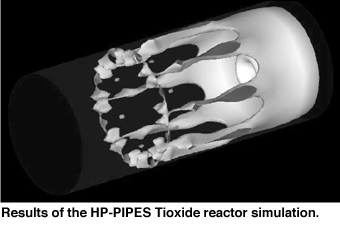
ERCIM News No.36 - January 1999

![]()
ERCIM News No.36 - January 1999
APEX - Awareness and Promotion EXercise
by Mike Ashworth and David Emerson
APEX is a two-year project funded by the European Union ESPRIT IV programme. Its aim has been to promote the benefits of using High Performance Computing (HPC) in combination with Computational Fluid Dynamics (CFD) to support the next generation approach to industrial research and development in the process industries, with emphasis on the use of Information Technology for simulation and prediction. A multi-media CD-ROM describing the benefits of CFD and HPC has been widely and freely distributed throughout the European Community.
The very fast pace of change within HPC hardware and continuous developments of CFD software require a way of conveying information very rapidly. A specific goal of the APEX project was to develop a multimedia CD-ROM that could be distributed to relevant industrial companies. The CD contains detailed information about HPC and CFD and results from two industrial applications from the ESPRIT III HP-PIPES project (#8114). An additional important feature is a Cost Benefit Analysis (CBA) section that will allow senior management to consider the investment decisions and risks concerning such technology. The partners involved in APEX are:
- CLRC Daresbury Laboratory, Warrington, UK, responsible for the HPC section and industrial application of Tioxide reactor
- Instituto Superior Tecnico, Lisbon, Portugal, responsible for the CFD section and industrial application of EDP power station burner
- Paras Ltd., Isle of Wight, UK, responsible for the CBA section and project management.
The APEX CD highlights two industrial applications from the process industries. In collaboration with industrial partners, the HP-PIPES project developed a CFD code to solve the 3D incompressible Navier-Stokes equations and to augment the core code with modules describing the physics and chemistry of particular applications. It was demonstrated that advanced numerical simulation can be used as a realistic predictive tool for the design and operation of complex chemically reacting flows and combustion systems. The core code, developed at Daresbury Laboratory, describes fluid flow and heat transfer in process engineering systems and has been designed to exploit the power of massively parallel high performance computing systems. It has been written in a portable and modular form to facilitate the future development of modules for the specific features of particular applications.
An Industrial Application Example: Production of Titanium Dioxide
Tioxide plc, formerly owned by ICI, is one of the world’s largest producers of the white pigment titanium dioxide that is widely used in materials such as paints because of its good light scattering characteristics. The critical parameters of the product are the mean size of the particles, which dominates its scattering power, and the distribution of the different particle sizes about the mean diameter, which affects the range of wavelengths that are scattered and the resulting effectiveness of the pigment in materials such as paints.

The HP-PIPES code was designed to overcome limitations in the existing model of the titanium dioxide process, in particular in the areas of the physical and chemical modelling and in the resolution of the flow field. At the start of the project axi-symmetric simulations were taking approximately one month to converge. The parallel implementation reduced simulation times to a few hours. This opened up the possibilities of exploring in more detail the phase space of physical and chemical parameters embedded in the model, enabling improvements in the theoretical bases of the various physical and chemical sub-models and moving the models to three spatial dimensions better to simulate real reactor geometries. The ultimate aim of the HP-PIPES project was to develop a predictive model capable of determining the optimum reactor configuration and operating conditions so as to produce particles of a specified mean diameter and standard deviation.
The Titanium Dioxide chloride process occurs in a basic pipe reactor. The oxidation process involves several complicated stages which may include the nucleation, growth and coagulation of the titania particles and the dissociation and recombination of chlorine produced in the reaction. In general the reactors have multiple inlets through which the feed materials, titanium tetrachloride and molecular oxygen, are fed at various temperatures, velocities and mixture fractions. The products, and any unreacted input materials, flow through the reactor at high speed. Initially, titania particles are assumed to form as nuclei and these become larger through surface deposition and coagulate as they flow through the reactor. These various processes produce a continuous size distribution of titania particles with a broad distribution of sizes.
The particle growth process is modelled by discretising the size distribution in terms of a fixed number of size intervals characterised by a mean diameter. Each of the size classes is then treated as a distinct transported variable in its own right The models can employ anything up to 100 class sizes for high accuracy computations. The calculations of the various source terms describing the nucleation, growth and coagulation is extremely time consuming as the coagulation terms fully couple all the size class variables in each finite volume. It is obvious that three-dimensional computations for systems with this number of class size variables would be completely impractical and uneconomic in the absence of parallel systems.
The APEX CD-ROM
The APEX CD-ROM is an interactive multi-media presentation, which introduces CFD and HPC, shows results from two typical applications (a chemical reactor and a power station boiler) and guides the viewer through the investment decision process.
The CD-ROM is available cost-free from the contact address below or by filling in the electronic form on our Web Page http://www.dci.clrc.ac.uk/Activity/APEXPlease contact:
Mike Ashworth - CLRC Daresbury Laboratory
Tel: +44 1925 60 3663
E-mail: M.Ashworth@dl.ac.uk